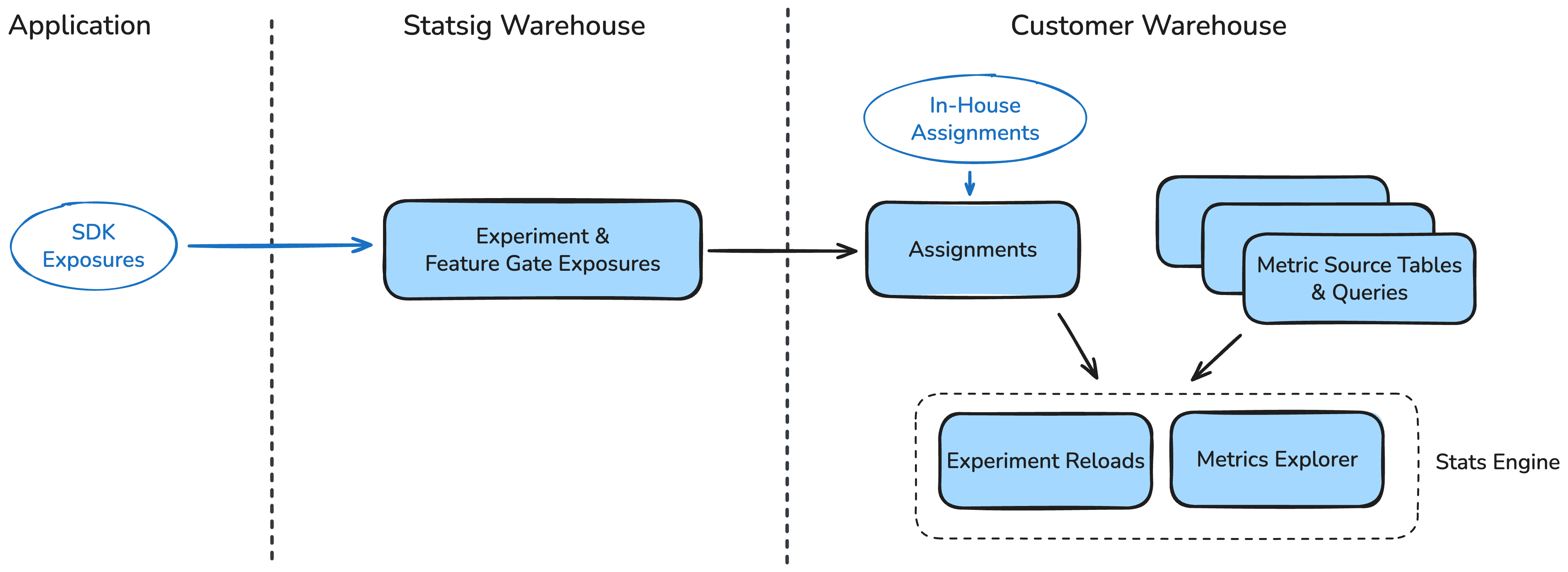About Warehouse Native
Statsig Warehouse Native is an enterprise-grade experimentation platform that runs analysis in your data warehouse. It integrates easily with your existing datasets and any source of experiment assignment data – including a powerful integration with Statsig's SDKs and real-time logging infrastructure.
Warehouse Native shares core features with Statsig Cloud but focuses on specific scenarios around running experiments on top of your warehouse.
Use Cases for Statsig Warehouse Native
- End-to-end experimentation platform covering targeting, experiment setup and assignment, and analysis.
- Features include Feature Flagging, Automated/Protected Rollouts, Native Holdouts, Mutual Exclusion, and comprehensive analysis tools.
- Modern statistical engine for running analyses on existing experiments from third-party or internal systems.
- Statsig offers a full suite of experiment measurement tools, including CUPED, Stratified Sampling, Switchback Tests, and more.
If you’re unsure whether Statsig Warehouse Native or Statsig Cloud is a better fit for your experimentation needs, reach out to our support team, your sales contact, or in our Slack community, and we'll help you decide.
How Warehouse Native Works
Statsig Warehouse Native runs experimentation compute jobs directly in your data warehouse, using your existing datasets to calculate metrics and enrich experiment analysis based on your data.

SDK Integration
Using Statsig SDKs with Statsig Warehouse Native is similar to integrating with Statsig Cloud. Here’s a quick overview of the process:
- Set Up Targeting and Experiments: Create and manage experiments using the Statsig console.
- Initialize the SDK: Integrate the Statsig SDK on your client or server-side applications.
- Targeting and Assignment: Call the Statsig SDK to assign users to variants.
- Optionally provide a logging callback to store logs in your warehouse or use Statsig's real-time infrastructure for instant diagnostics and safe rollouts.
The resulting assignment and (optional) event logging data ends up in your warehouse, where you can connect it to other datasets for analysis. If you log to Statsig, data is exported on-demand for real-time analysis or in scheduled batch jobs.
Experiment Setup
Running experiments on Warehouse Native involves several key steps:
- Connect Statsig to Your Warehouse: Integrate Statsig with your data warehouse to access relevant datasets.
- Create Metrics: Define the input data and configure experiment metrics.
- Log Exposures: Log experiment exposures with Statsig or point to existing assignments in your warehouse.
- State Your Hypothesis: Formulate a hypothesis and choose scorecard metrics to evaluate the experiment.
- Run Pulse Analysis: Execute a Pulse analysis to test your hypotheses and measure the impact on scorecard metrics.
Advanced Analysis Tools
Statsig’s data analysis tools run directly in your data warehouse. All queries, intermediate datasets, and final results generated by Statsig will be available in your warehouse for auditing and custom analysis.
- Pulse Analysis: Pulse helps you test your hypotheses and measure the impact of changes on your scorecard metrics.
- Metrics Explorer: Visualize experiment metrics for your entire population and drill down into user behavior. Metrics Explorer is part of a broader suite of product observability tools, including Session Replay, advanced filtering, and custom dashboards.
- Exposure Analysis: Analyze your experiment's first exposures to debug and gain insights on your experiments in Metrics Explorer. Drill down into certain properties or understand how your experiments interact with one another.
Next Steps
We love helping people use Statsig. Don't hesitate to reach out to our support team, your sales contact, or in our Slack community.
Check our getting started guides to start running or analyzing an experiment in minutes: